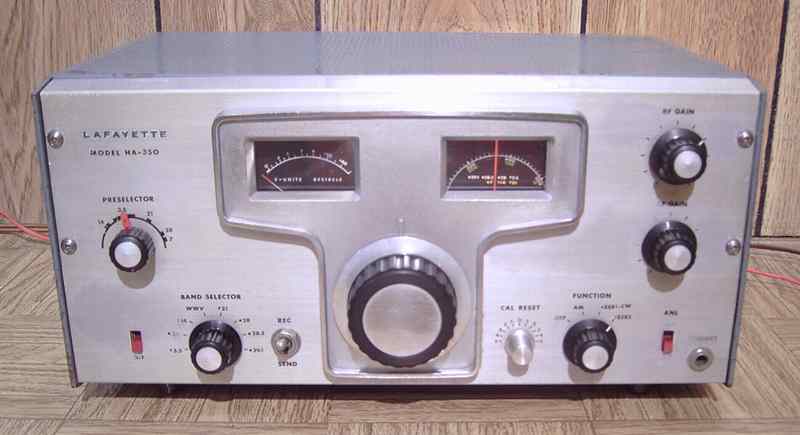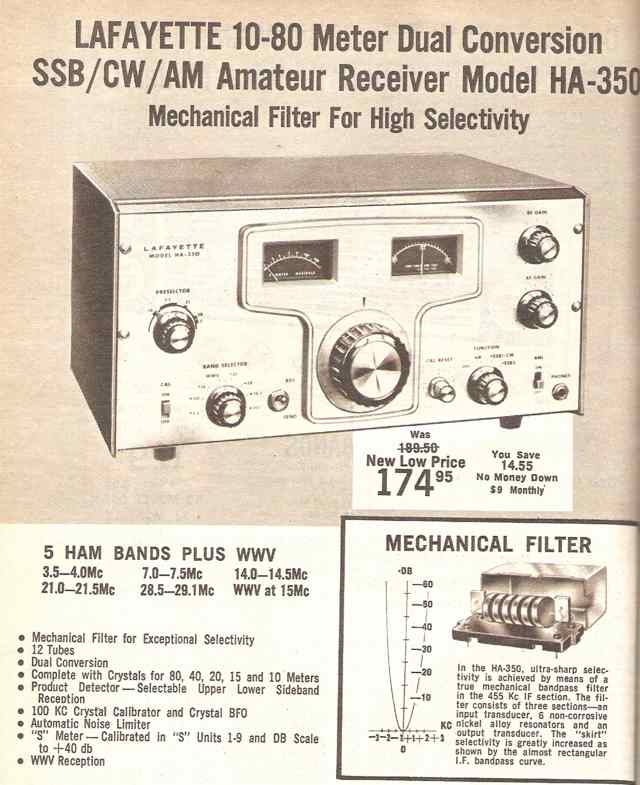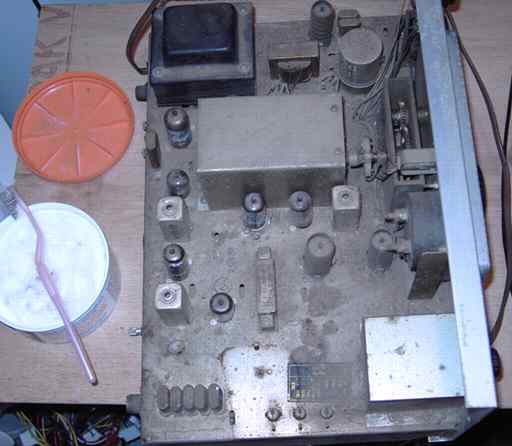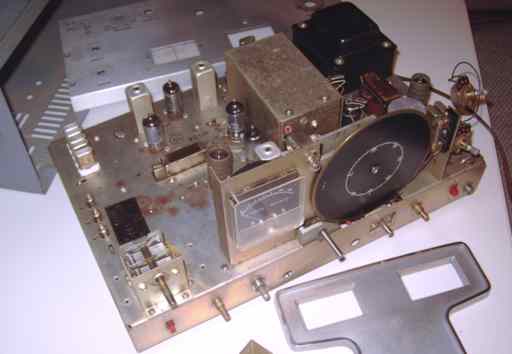
HA-350 in 1966 Lafayette catalog
The Lafayette HA-350 receiver is a ham-bands-only receiver covering 80 to 10 meters. It uses the 80 meter band as a tunable IF with crystal-controlled converter for the other bands making it single conversion for 80 meters and dual conversion for the others. The IF chain is 455 KHz and uses a mechanical filter. The receiver was made in Japan by Trio (now Kenwood) and was also sold as the Trio JR-300S. It was manufactured from 1964 to 1968.

HA-350 in 1966 Lafayette catalog
Repairs
The Lafayette HA-350 manual is available from BAMA. See my homepage for a link.
I removed the chassis and front panel, and then cleaned with white waterless hand cleaner. As can be seen in the before and after pictures below, the chassis was filthy and the metal had suffered some corrosion.

Beginning the cleaning of a dirty chassis

HA-350 chassis and parts after cleaning
The 80 and 40 meter bands were working well, but the other bands were dead. The cause was the crystal oscillator was not functioning for the other bands. Thinking the crystals might be dead, I checked each crystal in series with my signal generator and scope. They were all fine and on frequency. It turns out that the plate tuning coils for this oscillator circuit can be so tuned that the oscillator ceases to function. This was my first encounter with that type of circuit. I used my wide-band oscilloscope to adjust each of the oscillator plate coils. I could see the oscillator activity on the scope with the 10X probe close to but not touching the circuit. I then tweaked each of the plate coils for maximum oscillator activity to the point of stopped oscillation and then backed off about one turn. The manual suggests such a procedure using AVC voltage but does not provide enough detail. I followed up with an RF alignment. Final sensitivity was excellent on 80 meters and also very good on the other bands. In fact, the receiver seemed quite hot. I listened to SSB transmissions with just a few feet of wire for antenna. I cleaned and lubricated the tuning gearing. That solved a bit of backlash caused by friction between the spring-loaded split gears.
Operating the set
The set has more than adequate sensitivity with a very sharply tuned preselector. A Japanese source mentions the HA-350 as the first ham radio other than Collins to use a mechanical filter. Whether that statement is true or not, the mechanical filter does an excellent job of limiting bandwidth for very good selectivity. The crystal calibrator and optional 100 KHz crystal, installed in this set, allow accurate tuning.
The main problem I found with the set was drift until thoroughly warmed. It took about 45 minutes of warm-up for the set to settle down. I kept having to retune forward while listening to a long SSB conversation/ round-table QSO. The problem was aggravated by the tuning speed. I kept wishing for a bandspread knob or greater vernier action so I could tune an SSB frequency more easily. I occasionally resorted to using the little calibrator knob for just a bit of bandspread. It is possible my set was unique in this regard. Let me know your experiences. Given the price and 1964 technology and assuming a full warm-up, the set is a decent performer.
Comments:from Tom - W0EAJ
Nice find!
In the ARRL Book on Vintage Radio, this receiver is mentioned as one of the many "75A4 Clones" in one of the articles. I never thought of it as a (Collins) 75A4 clone, but my buddy had one years ago, and that silly thing WAS hot. Allied made one of 'em very similar to it as well.
Yes the tuning was fast, but this radio was so much better than anything I had up until then, it didn't matter. Eventually I purchased a used Drake 2B. I gave away the Drake in the 80s (stupid I know). I have absolutely no idea what happened to the HA-350.
Three Push-pull 6V6 amps were the previous items on the bench.